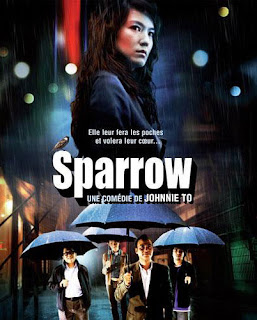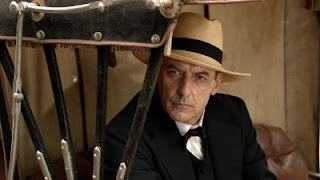The Master, the latest film by American ingénue Paul Thomas Anderson, is a demanding and frustrating film. I have no problem with it being demanding, but the film needs to meet its audience somehow, and that’s where The Master reveals its Achilles heel. Anderson’s major works to date, Magnolia and There Will Be Blood, hum with a dynamic tension that makes the films’ three hour running times fly by and present the viewer with a point of entry into the film unvierse, usually through a sympathetic character. Both of these films represent some of the best American filmmaking of the past twenty years, so expectations were high for The Master. But Anderson also made Punch Drunk Love, the oddly ineffectual drama with Adam Sandler; this film plodded onward driven by Sandler’s solid performance.
With The Master, it’s once more the performances that drive the film. For most part, the electricity that flowed from every frame of There Will Be Blood has been replaced by scenes that seem strangely static. Not all of the film has this problem; there are moments, such as the “informal processing” scene and a power-establishing scene between the titular character and his wife, that make the film come alive. Still, these scenes are few and far between. Another problem is that the film’s main character is a simple-minded and offensive WWII Navy veteran, Freddie Quell. Quell is a fevered character thoroughly rooted in all sorts of conflict, yet is the single most boring character in the film. He likes sex, liquor and farting. He is an all surface character in a complex film, and it doesn’t fit. Some will argue that Quell holds a mirror up to the far more intelligent Lancaster Dodd, and even so Quell is not nearly as compelling as Dodd.
We are introduced to Freddie (Joaquin Phoenix) while he’s still in the Navy, and Anderson makes it clear that the man is somewhat sex focused and has little social skills. To his credit, he is a master distiller. Back in the States, Freddie has a hard time holding on to jobs and one evening he slips onto a boat where a lavish party is being held. His choices have brought him into the company of Lancaster Dodd (Philip Seymour Hoffman), often simply referred to as the Master, the author of the worldview-challenging The Cause and currently working on its long awaited follow-up. For reasons that are hard to pinpoint, the sophisticated Dodd takes the intellectually limited Freddie under his wing. There is a third party in this power relationship, Dodd’s wife (Amy Adams), whose crucial role becomes clear only later on and had me wishing to spend more time with her than with Quell.
The three main performances in this film are all worth savouring; Adams seemingly has little to do but she is a force of nature when required, while Hoffman presents another fascinating, rather walled-off character. But it is Phoenix who completely embodies Freddie as a broken man who goes through life without any idea where he’s going. As much as I have issues with the character, Phoenix cannot be faulted; he surrenders himself to a challenging role.
The Master is far from a failure. The cinematography is superb, as one can expect from an Anderson film, and there are parts of the film that are inspired and enthralling (Quell’s hallucination at a Cause get-together). As a whole, though, Anderson’s film doesn’t quite come together. Additional viewings may change this perception, but for now, The Master lacks the compelling character ensembles and rhythm of previous Anderson films.
Note: much has been made of The Master as based on the life of L. Ron Hubbard and Scientology, but don't expect anything salacious. It's simply not Anderson's nature.
With The Master, it’s once more the performances that drive the film. For most part, the electricity that flowed from every frame of There Will Be Blood has been replaced by scenes that seem strangely static. Not all of the film has this problem; there are moments, such as the “informal processing” scene and a power-establishing scene between the titular character and his wife, that make the film come alive. Still, these scenes are few and far between. Another problem is that the film’s main character is a simple-minded and offensive WWII Navy veteran, Freddie Quell. Quell is a fevered character thoroughly rooted in all sorts of conflict, yet is the single most boring character in the film. He likes sex, liquor and farting. He is an all surface character in a complex film, and it doesn’t fit. Some will argue that Quell holds a mirror up to the far more intelligent Lancaster Dodd, and even so Quell is not nearly as compelling as Dodd.
We are introduced to Freddie (Joaquin Phoenix) while he’s still in the Navy, and Anderson makes it clear that the man is somewhat sex focused and has little social skills. To his credit, he is a master distiller. Back in the States, Freddie has a hard time holding on to jobs and one evening he slips onto a boat where a lavish party is being held. His choices have brought him into the company of Lancaster Dodd (Philip Seymour Hoffman), often simply referred to as the Master, the author of the worldview-challenging The Cause and currently working on its long awaited follow-up. For reasons that are hard to pinpoint, the sophisticated Dodd takes the intellectually limited Freddie under his wing. There is a third party in this power relationship, Dodd’s wife (Amy Adams), whose crucial role becomes clear only later on and had me wishing to spend more time with her than with Quell.
The three main performances in this film are all worth savouring; Adams seemingly has little to do but she is a force of nature when required, while Hoffman presents another fascinating, rather walled-off character. But it is Phoenix who completely embodies Freddie as a broken man who goes through life without any idea where he’s going. As much as I have issues with the character, Phoenix cannot be faulted; he surrenders himself to a challenging role.
The Master is far from a failure. The cinematography is superb, as one can expect from an Anderson film, and there are parts of the film that are inspired and enthralling (Quell’s hallucination at a Cause get-together). As a whole, though, Anderson’s film doesn’t quite come together. Additional viewings may change this perception, but for now, The Master lacks the compelling character ensembles and rhythm of previous Anderson films.
Note: much has been made of The Master as based on the life of L. Ron Hubbard and Scientology, but don't expect anything salacious. It's simply not Anderson's nature.
























